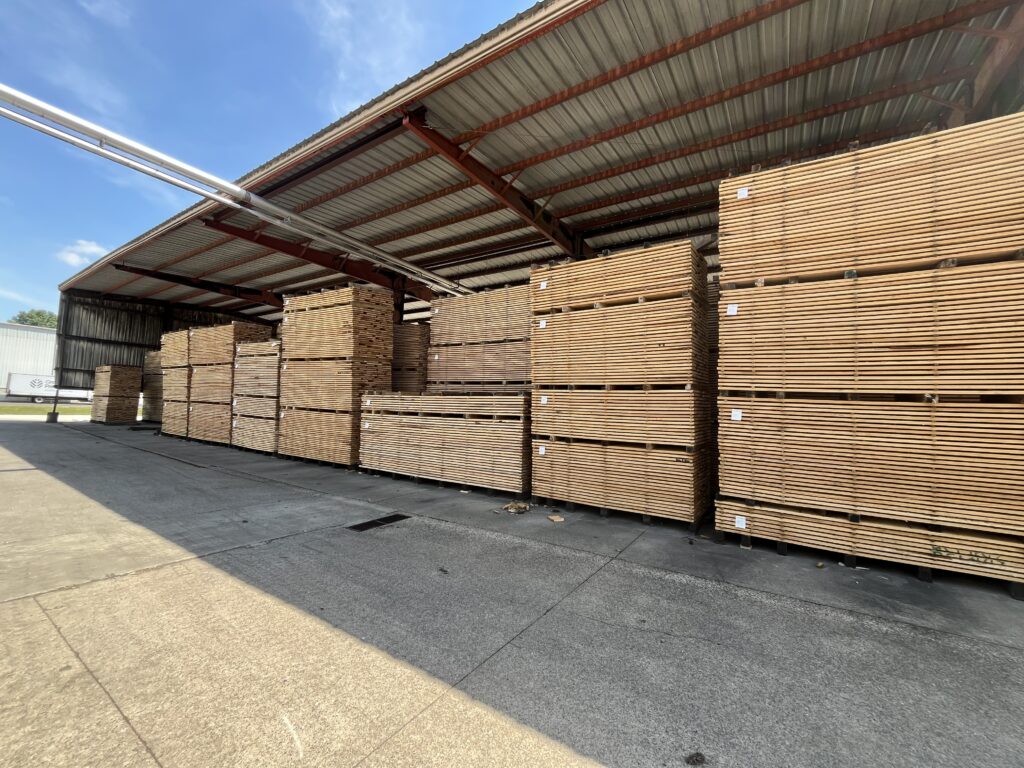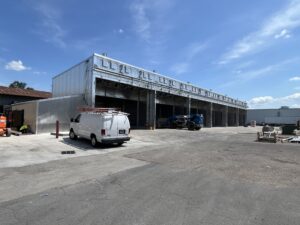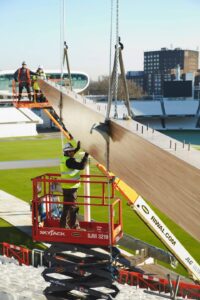Profile
Robinson Lumber Company Expands Indiana Facility
By Hallie Koontz

Robinson Lumber Company, which recently celebrated its 130-year anniversary in 2023, has been in the Robinson family for five generations. Each generation has added something: the first, alongside founding the company, began exporting high-quality long leaf pine around the world; the second imported the first sawn mahogany lumber from Mexico; the third imported the first Jatoba lumber into the United States; and the fourth established a foothold in domestic hardwood with the building of its New Albany, Indiana, facility. Now the fifth generation, helmed by Wesley Robinson, is expanding the company’s presence in the North American hardwood market.
One avenue taken by Robinson, who has worked in his position as North American Hardwood Lumber Manager for 10 years, includes the expansion of his company’s drying facility in New Albany, founded by his father in the fourth generation. In addition to the new acquisition of land in 2023, the expansion of the Indiana center includes a new bank of SII kilns to aid in the center’s growing output. After modernizing and expanding, the Indiana concentration center will process 6.2 million board feet of high-quality lumber per year, almost double the current rate of 3.5 million board feet.

In a way, the expansion feels like a return to company and family roots. Although the company’s headquarters is in New Orleans, the 1893 founder, Charles Wesley Robinson, was an Indiana native who moved the company from its founding state for the opportunity to export from Louisiana. The ability to sense lucrative and long-term beneficial opportunities seems to be a family trait.
“Over the generations, we have the tendency to find niches that we do well in. This is a niche we found 35 years ago,” Robinson says, talking about the company’s specialization in the highly coveted American white oak.
The Indiana facility deals in 90% white oak and 10% hickory, which is a rare specialization – an article in the Harvard Business Review celebrating the company’s longevity in 2021 even went so far as to describe the combination as one that, “if one were building a company from scratch, would not make sense to combine into one business.” But this specialization has allowed Robinson Lumber Company to corner and serve an important niche, as their focus allows them to offer pulled-to-width and ripped-to-width white oak strips for a variety of needs. While they do steady business with their hickory – which goes into flooring, trim, doors, cabinets, and drum sticks – their specialty in the pulled-to-width and ripped-to-width strips of white oak has led the company to focus on flooring in particular.
The focus is serving them well. In 2022, the company reported a record revenue over its entire history, which was then 129 years. Robinson believes the pandemic played a part in the revenue bump – with the shutdown in travel and the increased time spent at home, all the money that likely would have gone to funding vacations went to home remodeling instead. Of course, the current popularity of white oak doesn’t hurt, either.
“White oak is very much in style right now,” says Robinson, explaining how the preference has shifted from the earthier browns favored in 2022 back to white-washed oak in recent years, which is liked in particular by the ultra-wealthy. Although the price of white oak crashed in 2022, it’s gone up significantly over the past two years thanks to this new demand coupled with a tightness in supply. Because the majority of quality white oak on the market is going toward whiskey barrels and veneers, there isn’t much availability left for sawing into grade lumber for flooring and furniture. This is where the Robinson Lumber Company niche excels – while they do sell their white oak to distribution and other manufacturing, they skip selling to whiskey barrel makers and choose instead to focus on their specialty, the flooring industry. Other projects the Robinson Lumber Company has provided American white oak for over the last decades include the Museum Hof Van Busleyden and Museum aan de Stroom in Belgium and the Lord’s Cricket Ground in London.

As far as managing their own supply, key relationships forged by Robinson Lumber Company allow them to source all their materials locally from within a 300-mile radius. This helps cut down costs while maintaining their commitment to responsible and sustainable harvesting. “We bring in lumber from 300 miles because if we went further, it would cost more. At the same time, it would be more fuel, more negative results on greenhouse emissions,” Robinson explains.
In addition to sourcing all their wood from that local 300-mile radius, the company is committed to making sure the green lumber they purchase from their partner sawmills is sustainably harvested. Selectively harvesting the largest, oldest trees that are declining in growth rate in their old age and that have captured the most carbon over the years prevents those trees from falling over on their own and releasing more carbon into the air as they decompose. Instead, that carbon is trapped in the wood itself, where it will stay as long as people use it for flooring—which could be a while, considering the ability of hardwood floors to add long-term value to a home over time.
“My generation and younger have an IKEA mentality, is what I call it,” Robinson adds when discussing longevity. Younger generations are less likely to invest in building up and improving a home because they aren’t sure they’ll be there long enough to justify the investment. But Robinson is a supporter of these long-term investments, citing a core belief he aims to spread in the industry and beyond: “wood is good.”
“Lumber is the ultimate renewable resource. It is the only thing that regrows that we use for building,” Robinson says. His recent appointment to the board of the Indiana Hardwood Lumbermens Association (IHLA) and his company’s membership in a broad collection of sustainability organizations are proof of his dedication to this core belief. Robinson Lumber Company has been certified by the Forest Stewardship Council (FSC), and this past April they renewed their certification through 2029. Other organizations they belong to include the Appalachian Hardwood Verified Legal (AHVL) program, the American Hardwood Export Council (AHEC), and the Hardwood Manufacturers Association (HMA), the only national trade organization with membership limited to hardwood sawmills and lumber concentration yards located in the United States.
Beyond its versatility and renewability, other reasons Robinson wants to spread the wood-is-good message include its ability to create jobs in the forestry and lumber industries and the amount of warmth it brings to your home in comparison to other materials like vinyl plastics (going back to the “IKEA mentality”), all without needing to be treated by chemicals.
Robinson Lumber Company describes itself as “an old company always doing new things.” It’s certainly got the old part covered, with its 130 years of operations and its fifth generation steering it through 2024 and beyond. Its commitment to sustainability and responsible forestry showcases how the company puts long-term survival over short-term profits. It’s already passed the three-generation benchmark, and the fifth generation isn’t nearly done yet. NL
